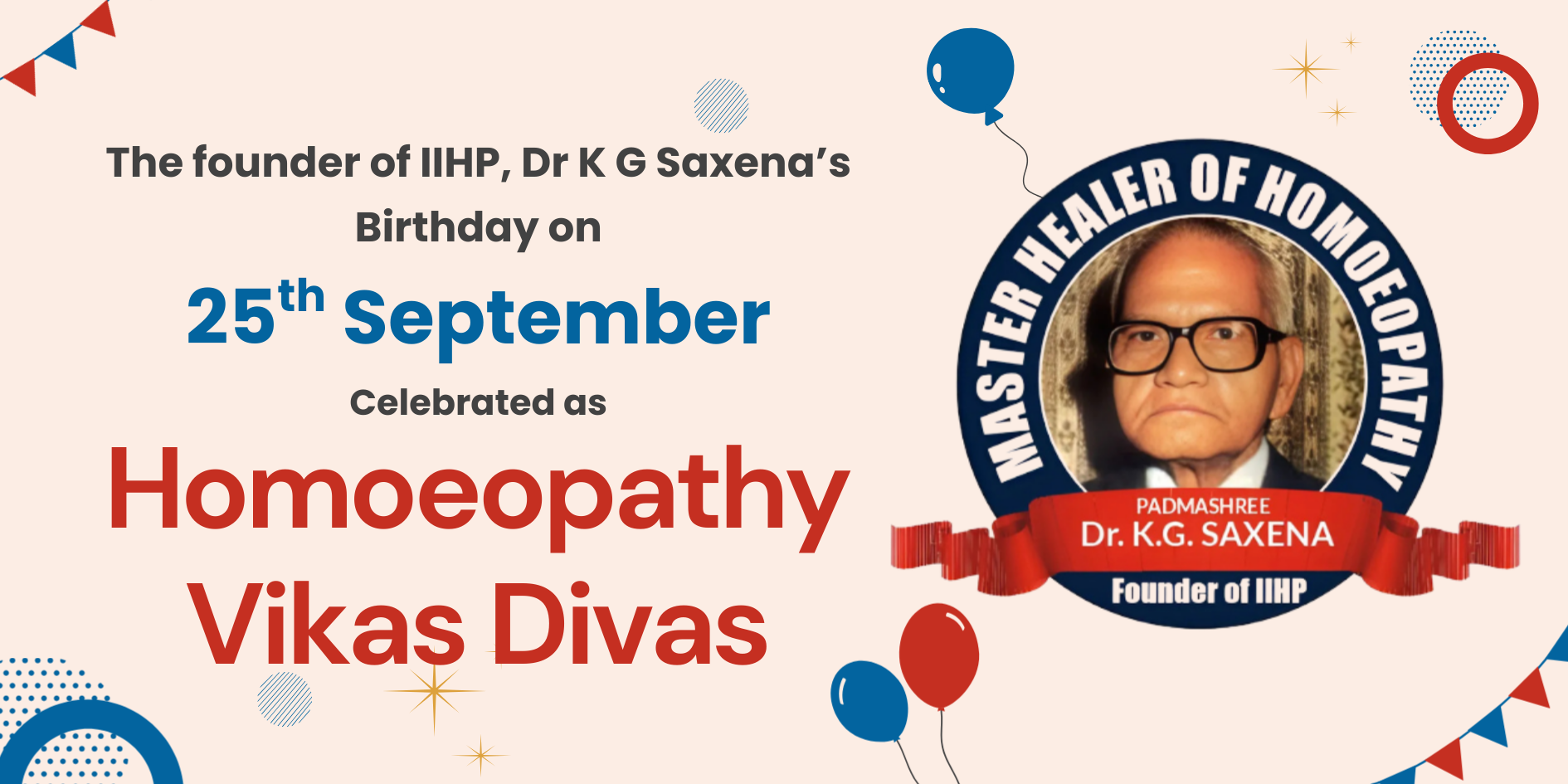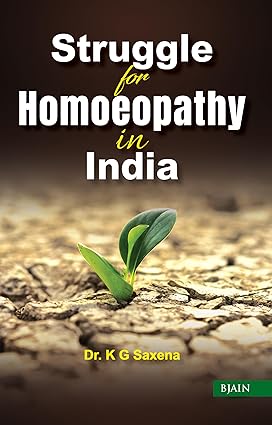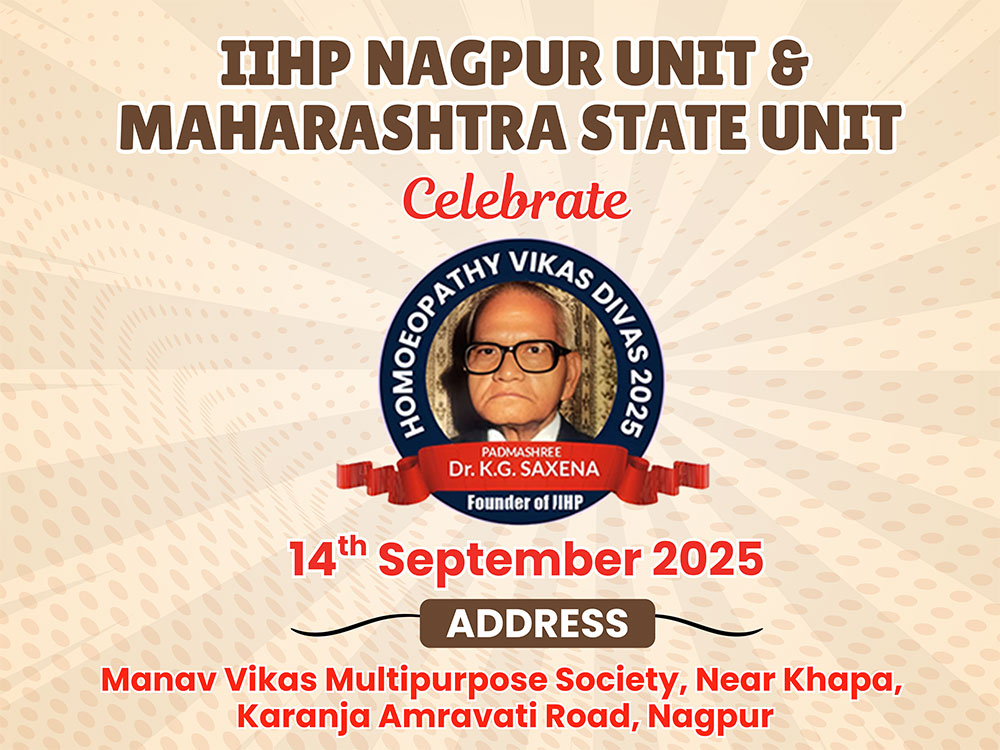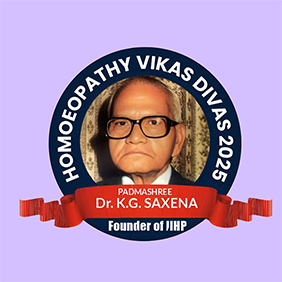
Importance of Homoeopathy Vikas Divas
Why Celebrate Homoeopathy Vikas Divas#HomoeopathyVikasDivas
In progressive societies there are heroes and there are leaders but in Dr K G Saxena we see the qualities of both. He had the heroic vision of future of homoeopathy and he not only knew how to make it bright he dedicated his life to make it a possibility through a well-planned movement called IIHP. He not only showed us the goal he showed us the way how it can be achieved and also initiated the journey. During this journey to establish homoeopathy as a strong and officially recognised health modality he not only crossed but also established many milestones.
We need to celebrate such #HeroesOfHomoeopathy. On the occasion of #HomoeopathyVikasDivas we reaffirm our dedication and devotion to serve homoeopathy. We need to celebrate our heroes through celebrating their birthdays so that their legacy continues, their stories are not forgotten and continue to inspire for generations to come, so that their courage and vision continues to motivate others to lead, serve, and innovate. Their actions have shaped history and value of homoeopathy. They represent the ideals of a community and we need to acknowledge their sacrifices while fostering a culture of appreciation and empathy.
How to Celebrate Homoeopathy Vikas Divas
Celebrating the contributions of our leaders and heroes is essential to honor their legacy is a small aspect of a celebration, but to inspire future generations to follow in their footsteps, to learn from their qualities is an important aspect which will strengthen the fabric of our fraternity. Here's how we should do it -
Public Recognition
Commemorative days - Celebrating Dr K G Saxena’s birthday on 25th September as Homoeopathy Vikas Divas
Storytelling
We need to include his stories in homoeopathy curriculum to teach values and history.
Read his biography in group meetings and classrooms in the institutes on his birthday
Read passages from his book – Struggle for homoeopathy
Creative Tributes
Organise and present Art, music, and theatre performances inspired by their lives.
Public exhibitions in community spaces describing his life and contributions to homoeopathy
Write and create Books, documentaries, and podcasts that explore their lives and impact.
Community Engagement
Volunteer drives or social campaigns in their name
Memorial Lectures, Seminars, Webinars, Essay competitions and Health Camps
IIHP has instituted a Lifetime Achievement Award in the name of Dr K G Saxena to support emerging change makers.
Digital Celebrations
Social media tributes and hashtags to share stories widely.
Virtual events and webinars that explore his legacy.
History of recognition of Homoeopathy in India dates way far back to 1937 when an young and dynamic Homoeopathic graduate from Calcutta Homoeopathic Medical College came out of the College to start Homoeopathic practice in Delhi. He is none other than late Padmashree Dr. K.G. Saxena who had spent his whole life struggling for the cause and development and recognition of Homoeopathy in the country. This great personality was the champion for the Homoeopathic profession, and instrumental in getting recognition for Homoeopathy by laying the road map for the success of Homoeopathy in India.
Homoeopathy is the only system which has a psychosomatic approach to illness. It depends on individualising the patient. Homoeopathy utilises the present day methods of Science, Hygiene, Sanitation and Nutrition, along with techniques of prevention and control of disease, reckoning with the psychological reactions of the patient.
Page 2, Struggle for Homoeopathy in India
Born on 25th September 1912 to a middle class Kayastha family in Delhi, had his early education in Ambala Cantt., Karachi and Delhi, where he had completed his schooling with distinction. He passed his intermediate from Hindu College Delhi. His father was a soldier and an ardent Homoeopathic supporter. He used to prescribe Homoeopathic medicines to his entire family. At the instance of his father, Dr. K.G. Saxena took admission in the prestigious Calcutta Homoeopathic Medical College Calcutta in Bengal.
Calcutta was the seat of Homoeopathic education in those days India and the system was very popular in entire Bengal. Eminent and top Homoeopathic Physician Dr. B.K. Bose who was the direct disciple of Master J.T. Kent was associated with this college in those days. Other eminent personalities associated with this college were Dr. G.N. Sinha, Dr. A.B. Malik, Dr. P. Saha, Dr. A.N. Mukherjee, Dr. S.N. Ghosh, and Dr. B.B. Mukherjee. Dr. B.K. Bose was his mentor and a role model.
Homoeopathy had no recognition from the Government and naturally no career was open in government service, to its practitioner. Government rather labelled it as quackery and tolerated it only as a necessary evil. A trained and a qualified doctor in Homoeopathy was equally termed or treated as quack and even the teaching institutions in Homoeopathy received little respect. Entry into government service, which used to be a very coveted profession those days, was impossible on the basis of a Homoeopathic degree.
Page 8, Struggle for Homoeopathy in India
Dr. Saxena got his leadership qualities during his studies in Calcutta. He fought for the quality education and good facilities when he found that the standards of Homoeopathic education were not up to the mark in the institute.When Dr. Saxena came out from the college after completing his graduation in Homoeopathy, he could realize that the Homoeopathic system was not recognized in the country by the Government, he decided to take this onerous task of getting the recognition from Govt. on him. His experience as a student leader came to his aid. He focused his full attention towards one goal that is getting recognition to Homoeopathy by the Government, that looked a herculean task. But he had accepted the challenge in real sense inspite of limited resources and limited supporters. Dr. Saxena, after completing his Homoeopathic graduation shifted to Delhi and settled in his family life. His wife was very supportive and could understand his aim in the life.
My struggle for development of Homoeopathy started in earnest after I started my practice in Delhi, on return from Calcutta. I had no resources to fight this battle other than my devotion and zeal and my sincere conviction that this great scientific and potentially useful healing art could be utilized for the service of humanity. In the prevailing environment in India, the first logical step obviously was to rouse the 3interest of the Government and at least change their attitude towards this system
Page 14, Struggle for Homoeopathy in India
The real struggle in his life started after his arrival in Delhi with a degree in Homoeopathy. He had set up his private practice in Delhi in real earnest. By this time, he came to know the attitude of the Govt. towards Homoeopathy as it was considered that this system of medicine was an unscientific method and needs no encouragement. He felt that convincing the govt. about the efficacy of Homoeopathy was more a difficult task than convincing the political set up. Hence he had focused his attention towards members of Central Legislative Assembly, the highest decision making political body at that time. He had studied the functioning of this political body and how an unofficial Resolution could be brought to the Legislative Assembly. For this task he was needing the support of at least 20 Legislators to sign and move the private (unofficial) resolution in the Assembly.
Being very young in the age, he found it difficult to convince the Legislators as they did not take him seriously. This did not deter him as some Legislators supported him in this crusade. With the support of some Legislators the resolution was moved in the Assembly and fortunately it was accepted for discussion. This was his first success towards his ultimate goal. The Legislative Assembly authorized Mr. Ghiasuddin the honourable Legislator from Punjab province to move the resolution in the Central Legislative Assembly. Though Mr. Ghiasuddin was not knowing much about Homeopathy he had agreed to move the resolution after being thoroughly convinced by Dr. Saxena about the merits of Homoeopathy.
The resolution in the highest political body of free India, the Parliament, had a very encouraging effect on the morale of the profession. It was now officially considered to be a scientific and good system which should play its proper role in society. The government showed its political will to boost up the system and develop it through governmental support on rational lines. The Enquiry Committee did a comprehensive job investigating all aspects of the system and made exhaustive recommendations.
Page 18, Struggle for Homoeopathy in India
As per the rules the health was a state subject and this resolution needs the ratification from all state Governments. Hence this resolution was forwarded to all the states. Bengal was the first state to adopt this resolution and it was the first state to recognize Homoeopathy as a system of medicine in the year 1943.
In the year 1944 after the passing of the Homoeopathic resolution by Central Legislative Assembly a group of dedicated Homoeopaths consisting of stalwarts like Dr. A.N. Mukherjee, Dr. Dewan Jaichand, Dr. Dayashankar Kayastha, Dr. J.P. Srivatsava, Dr. S.P. Asthana and our Dr. K.G. Saxena formed a group to establish a Homoeopathic professional group to fight for the scientific development of Homoeopathy in India. They named this group as “All India Institute of Homoeopathy” with its central office at Delhi. Dr. K.G. Saxena was made the first General Secretary of this Institute.
The All India Institute of Homoeopathy was revived and designated as the Indian Institute of Homoeopathic Physicians in June 1980. A meeting of the Executive Council of the Institute was held in Delhi and elected Dr. B. K. Sarkar, Dr. Diwan Harish Chand, Dr. S. R. Wadia and Dr. Dr. M. C. Batra were nominated as Hon. Members of the Institute.
Page 58, Struggle for Homoeopathy in India
The Institute under the leadership of Dr. Diwan Jaichand and Dr. K.G. Saxena submitted its first memorandum to the Coalition Govt. at the Centre in the year 1946 for recognition of Homoeopathy by the Central Govt. With untiring efforts of Dr. K.G. Saxena the new resolution was put before the Parliament 0n 17th February 1948. The resolution was debated thoroughly in the House and adopted unanimously.
Govt. said that the resolution would be implemented provided a Govt. appointed Enquiry Committee, to be set up at a later time confirms and guarantees that the Homoeopathic system of medicine is a Scientific System of medicine. The Enquiry committee made the report and it was finally published in the year 1949 recommending Homoeopathy is a Scientific System of Medicine.
It is beyond my comprehension how Ayurveda, Siddha, Unani and Homoeopathy could function together especially when they have different principles and treatments on which they are practised and prepared. Then how could Nature Cure and Yoga have their place in the same directorate along with the four major systems mentioned above?
Page 65, Struggle for Homoeopathy in India
The Mission that has been embarked in the year 1937, passing through various obstacle, up and downs ultimately reached to a semifinal stage in the year 1974 when Govt. of India has established the Central Council for Homoeopathy.
As Advisor Homoeopathy to Govt. of India Dr. Saxena initiated many Govt. Committees for the development of Homoeopathy in the country. Notable among them were the Pharmacoepia Committee, Education Committee, Research Committee, Rural Homoeopathic Medical Aid Committee, Drugs and Technical Advisory Board, Family Planning Committee, primary Health Centres and CGHS Homoeopathic Dispensaries. National Institute of Homoeopathy is another brain child of Dr. K.G. Saxena. He persuaded Govt. to establish a higher Educational Institute on lines with All India Institute of Medical Sciences. With his efforts the NIH under Ministry of Health Family Welfare was established in Calcutta in the year 1975.
By participating in this world forum, India's contribution to Homoeopathy was known to the world. The resolutions at such Congresses also impressed the national governments more than the views expressed by national bodies and participation in this activity imparted prestige to the national profession and professionals.
An International Homoeopathic Congress of the LMHI was held at New Delhi in 1967.
Page 81, Struggle for Homoeopathy in India
Dr. K.G. Saxena passed away in New Delhi on 23rd October 2003 after a remarkable journey of 91 years. His extraordinary efforts in laying foundation of Homoeopathy in this country and helping the science to achieve its present status here and abroad constitute his magnificent legacy. He was a great nationalist and always stood by honest and truth.
The vision of this great missionary has yet to be completely seen through. It is now our responsibility to take forward his legacy and establish Homoeopathy as first line of treatment in the primary health care delivery system in the country and also make sustained efforts to unfold the full potential of Homoeopathy including secondary and tertiary health care. His prediction that one day India would be the nucleus and citadel for Homoeopathy had come true.
In 1937 when I entered this field and dedicated my life to the cause of Homoeopathy, its recognition, formal and informal by Govt. and the public was a far, faraway dream. This was an impossible ambition and its devotion of an average, common person like myself, who had no assets but only conviction, determination and devotion, looked a futile and rather vain endeavour.
Page 89, Struggle for Homoeopathy in India
Book by Dr K G Saxena

Excerpts From His Book
| Page 2 | Page 8 | Page 14 | Page 18 |
| Page 58 | Page 65 | Page 81 | Page 89 |
Book Review (Struggle for Homoeopathy in India)
Someone has very wisely stated that a person who does not know his history cannot achieve the higher purposes of his life, because “Longer we see in the past, further we see in the future!”
Same stands true to our legend Late Dr. K.G. Saxena. His book takes us into a journey of progress of Homoeopathy in India with his narration and Herculean efforts in providing recognition of Homoeopathy in India.
Achievements of Dr. K.G. Saxena are exemplary and listless. Some of these are— He was the Honorary Homoeopathic Physician to six Presidents of India, i.e.:
- Dr. Rajendra Prasad
- Dr. S. Radhakrishnan
- Dr. Zakir Hussain
- Dr. V.V. Giri
- Sh. Fakhruddin Ali Ahmed
- Sh. Sanjiva Reddy
Dr. Zakir Hussain had honoured him with the highest civilian award — Padma Shri on 26th January 1969. He was the first Homoeopathic doctor to receive this award. IHP is the oldest registered performing organization in India established by Dr. K.G. Saxena.
He was joint national vice-president at International Homoeopathic League, former Homoeopathic Advisor to Government of India, and also former Chairman i.e.:
- Educational Committee, GOI
- Research Committee, GOI
- Rural Homoeopathic Medical Aid Committee, GOI
- Family Planning Committee, GOI
- Scientific Advisory Board, CCRH
- Drug Technical Advisory Board, DGHS
Dr. Sayeed Tanwir Hussain paid his tributes by saying that Dr. Saxena was the gardener and this Homoeopathic plant was watered regularly with his dedication of 55 years — making it a tree whose fruits are being enjoyed by us all today.
He was instrumental in opening dispensaries in CGHS, laying the foundation stone of CCRH, NIH, and Drug Standardisation Unit at Ghaziabad. His contribution to Homoeopathy is commendable. Now his date of birth, 25th November, is celebrated as Homoeopaths Vikas Divas.
This book tells us much about the struggle put in by Dr. Saxena — how he lobbied hard to pass the red tapism of allopathic bosses in the ministry?
How he tackled the objections raised by red tapism
How he convinced the then ministers for bringing recognition ? It should be part of the curriculum of all students of Homoeopathy.
Dr. Sudha Banerji
MD
Courtesy: Vital Information, Volume 33, Issue No. 07, July 2025
Programmes’ Schedule & Related Media of HVD 2025

Dr K G Saxena Birthday Celebration by IIHP Nagpur District Unit & Maharashtra State Branch
Date: 14th September 2025, Sunday
Place: Manav Vikas Multipurpose Society, Near Khapa, Karanja Amravati Road, 70 kms from Nagpur
- Fee : Call
- Distribution of Blankets, towels and toiletries etc. will be done.

CME Programme and Investiture Ceremony of IIHP Nizamabad Chapter & Telangana Satate
Date: 14th September 2025, Sunday, 10am to 3pm
Place: Hotel Nikhil Sai International, Hyderabad Road, Nizamabad, Telangala
- Fee : Call

IIHP Visakhapatnam and Andhra Pradesh Units are Celebrating Homoeopathy Vikas Divas
Date: 21st September 2025
Place: NSS Bhawan, Andhra University, Visakhapatnam
- Free

IIHP Jaipur Is Organising Webinar with Dr Dr Vidul Vithal to Celebrate Homoeopathy Vikas Divas
Date: 25th September 2025
Place: WWW
- Free

IIHP Women’s Cell Kalaburagi Celebrates Double Dhamaka
Date: 27th September 2025, from 11am onwards
Place: National Degree College for Women, Kalaburagi, Karnataka
- Fee: Call

13th Dr K G Saxena Memorial Lectures by IIHP Delhi State Branch
Date: 28th September 2025, Sunday- 9-5pm
Place: Dr B R Sur Homoeopathic Medical College and Research Institute, Moti Bagh, New Delhi
- Fee
- Doctors : 1500/-
- Students : 500/-
- Stalls : 12000/-

Dr K G Saxena Birthday Celebration by IIHP Bareilly District Unit
Date: 28th September 2025, Sunday- 3-5pm
Place: Dr Sudahnshu Arya Clinic, 68 Civil Lines, Anathalaya Marg, Bareilly
- Fee : Call
- Free for IIHP Members

Birth Anniversary Celebrations of Padmashri Dr K G Saxena as Homoeopathy Vikas Divas by IIHP Lucknow SCR Unit
Date: 28th September 2025, Sunday, from 2pm
Place: Dr O P Srivastava’s Centre for Advance Study in Homeopathy, Jankipuram, Lucknow
- Fee : Call

IIHP Jhajjhar Is Organising Free Homeopathic Camp to Celebrate Homoeopathy Vikas Divas
Date: 28th September 2025
Place: Mata Sheobai Bansal Cheritable Homoeopathic Aushadhalaya, Jhajjhar
- Fee : Call

IIHP Chennai and Tamilnadu State Branch Celebrates Homoeopathy Vikas Divas – CME on Viral Fevers and Ophthalmic Disorders
Date: 28th September 2025, Sunday 4-5pm
Place: Madan Homoeo Clinic, Chennai
- Fee : Call
